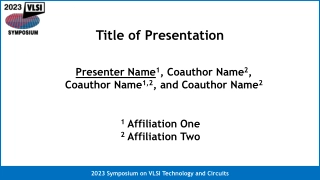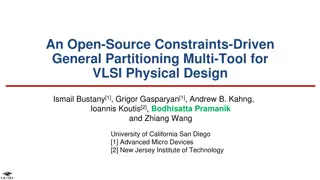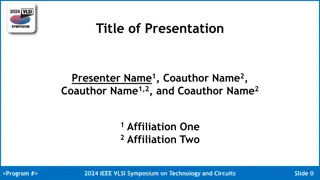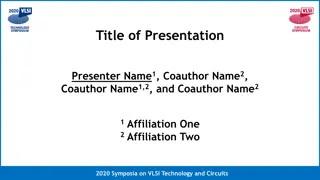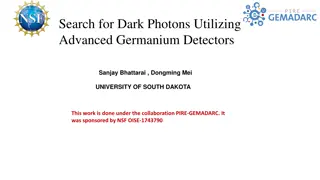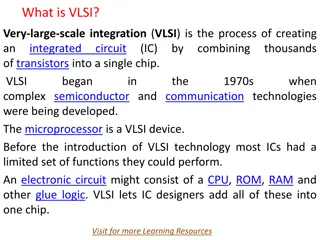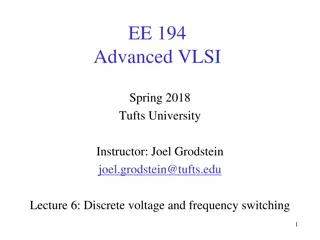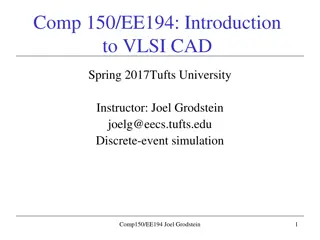Advanced VLSI - Dark Silicon and Power Management Challenges
Explore the complexities of VLSI design including the concept of dark silicon and the challenges of power management in modern microprocessors. Delve into strategies such as conditional clocking and DVFS to address these issues in the ever-evolving field of semiconductor technology.
Download Presentation

Please find below an Image/Link to download the presentation.
The content on the website is provided AS IS for your information and personal use only. It may not be sold, licensed, or shared on other websites without obtaining consent from the author. Download presentation by click this link. If you encounter any issues during the download, it is possible that the publisher has removed the file from their server.
E N D
Presentation Transcript
EE 194 Advanced VLSI Spring 2018 Tufts University Instructor: Joel Grodstein joel.grodstein@tufts.edu Lecture 7: Dark silicon 1
Resources The future of microprocessors, Shekhar Borkar 2011 The past 20 years were the great old days ; the next 20 years will hopefully be the pretty good new days Good overall description of dark silicon, multiple heterogeneous cores, accelerators, futures Computational sprinting, HPCA 2012 Read this for Wednesday EE 194/Adv. VLSI Joel Grodstein 2
Power problems, yet again The same old problem: # of devices is rising at a slower and slower rate But still faster than power/device is falling Arguably the central problem of VLSI nowadays. Time to look at the problem one more time, and see how much we like our solutions so far EE 194/Adv. VLSI Joel Grodstein 3
Mini-quiz (review) Why is Moore s Law slowing down? It s getting hard to scale Vt, since it s approaching kT/q Dimensions are nearing quantum sizes So: manufacturing is getting harder. Why is Moore s Law not stopping? We ve mostly stopped scaling down V We re not at the quantum scale yet! Dennard scaling (i.e., constant fields and shrinking V) has close to stopped. Why? Again, it s getting hard to scale Vt The end of scaling down Vdd means that power is rising EE 194/Adv. VLSI Joel Grodstein 4
What have we done about it? What are the things we ve talked about to get around this big problem conditional clocking DVFS Multiple cores Let s go over them one by one EE 194/Adv. VLSI Joel Grodstein 5
Conditional clocking What was good about it? Turn off the clocks that aren t doing anything Also stops downstream data nodes from wiggling Makes our computation more efficient. What limits its application? Eventually you need clocks running if you re going to do computation Every generation, power gets exponentially worse; so if our solution is cond. clocking, then we have to turn off more and more clocks each generation! Conclusion: we need cond. clocking, but it s not enough. EE 194/Adv. VLSI Joel Grodstein 6
DVFS What was the central idea? Lower V,F and save power and energy (but run slower) What was good about it? lowering V/F is cubically good! What limits its application? it can be hard to know the correct V/F to run at Big-picture problem: if we really care so much about power, we really should be running at the lowest V possible and almost never raising V But when that doesn t give us enough computes/cycle, there s not real good answer other than raising V/F (which is inefficient). EE 194/Adv. VLSI Joel Grodstein 7
Multiple cores Why do we do multiple cores? Every generation we have more transistors to use We added lots of fancy architectural features: OOO, speculative, big caches But we got to where those techniques were adding more transistors, but the IPC wasn t getting much better and the energy/instruction was often getting worse! Now we usually do many smaller cores What was good about it? Small cores are more power-efficient than large ones What limits its application? Not every application can use lots of threads EE 194/Adv. VLSI Joel Grodstein 8
Heterogeneous cores How many cores should we put on a chip? 8 tiny cores? 4 small cores? 2 medium ones? One big one? The best answer depends on the application Assume: the problem we care about can be broken into 4 threads Ask the same question again: how many cores to build? Probably 4 small. Assume: now we care most about an app with 2 threads. Now? Then build 2 medium cores. What if we care about both apps? Build 4 small cores and two medium! Example: Apple A11 Bionic (the CPU that powers IPhone X). It has two fast cores and 4 slow ones. EE 194/Adv. VLSI Joel Grodstein 9
Heterogeneous 4 small cores and two big ones!?! And usually only use one set or the other!?! Why not 4 small cores, and crank up Vdd when we only have 2 threads? usually doesn t work as well as two larger cores. High V/F is cubically inefficient. Why not 2 big cores, and drop the voltage when we can? more parallelism = more efficient Hopefully we were already running at a low voltage Isn t that wasteful of area? Yes, but our premise is that we have more transistors than we know what to do with Isn t that wasteful of clock power? No, since we turn off the clocks in any unused core This is how we turn on fewer clocks every generation Don t the unused cores still have static power? Lower Vdd enough to reduce that Don t need to do it fast; this is DVFS-level granularity or even slower EE 194/Adv. VLSI Joel Grodstein 10
Video decoding Observations: we often watch videos on our phones! Video decompression is compute intensive Does conditional clocking help on video? Sure, but the parts of the die that are computing still have to clock And there s lots of computing Does multicore help on video? Maybe, if we can split decompression over multiple small cores Does DVFS help on video? We can adjust voltage to frame rate All of these are good but we can do better! EE 194/Adv. VLSI Joel Grodstein 11
Accelerators Where does a general-purpose CPU spend its power? Doing real work, and Circuits for speculative, OOO execution Moving data between memory/cache/regfiles and execution units Much of these are not really doing any computation! Ideas: Build a special-purpose machine Build just as many registers as we need for, e.g., MP4 Put the registers near the execution units Throw away speculative/OOO Result: a very power-efficient machine that does only one thing and is useless otherwise EE 194/Adv. VLSI Joel Grodstein 12
Group exercise Assume: we have lots of registers 8 variables are already in registers: A0, B0, A1, B1, A2, B2, A3, B3 We want to compute A0*B0 + A1*B1 + A2*B2 + A3*B3 General-purpose way: Write assembly code (e.g., for MIPS) to do the computation Design your own accelerator for it: Use as many multipliers and adders as you want The final result must go back into the register file Try to avoid putting intermediate results into the register file Which way will be more power efficient? Faster? EE 194/Adv. VLSI Joel Grodstein 13
More accelerators Accelerators have been around forever Any idea why nobody cared until recently? When CPUs got 2x faster every year, accelerators were not worth the trouble No reason to care about their power advantage in the past Example IPhone has a neural engine. Not sure if they have an MP4 decoder anywhere they re not telling (may be part of their GPU or video encoder) EE 194/Adv. VLSI Joel Grodstein 14
Dark silicon What is dark silicon? Lots of transistors available Cannot use them all at once (too much power) Solution: build more things than you will use at once Build multiple heterogeneous cores Build multiple accelerators At any give time, use the most efficient tool for your problem Leave the others idle, with stopped clocks and low Vdd Idle units are dark silicon EE 194/Adv. VLSI Joel Grodstein 15
Computational sprinting Chief ideas: Observation: we often only need intense computing for a short time We might not care as much about instantaneous power as about chip temperature Chip + package + heat sink combination has substantial thermal mass; its temperature may take a while to rise substantially You can run at a long-term-unsustainable power level as long as you don t do it too long EE 194/Adv. VLSI Joel Grodstein 16
Discussion questions What are the main assumptions that the paper makes about how the proposed chip would be used? Do you think they are valid? They only talk about using multiple small cores. Why not use heterogeneous cores? What type of thermal time constants do you think they are talking about? The more thermal mass you have, the longer you can sprint for. Are there any downsides of having more thermal mass? What are phase-change materials, and why do the authors like them? What do they do if the chip reaches maximum temperature and the user is still demanding lots of computes? What about di/dt issues? What are your overall thoughts on the paper? EE 194/Adv. VLSI Joel Grodstein 17


